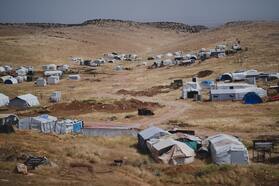Liberation without Freedom: The Complexities of PTSD for Yazidi Women in Post-Conflict Iraq3/20/2022  Mental health is recognised as a significant challenge for both the individual and collective post-conflict community. Both men and women who survive atrocities during conflict, such as hostage taking, torture and killings suffer high levels of trauma. When such atrocities constitute genocide, they are directed at an entire group, affecting the entire social environment and not just the individual victim. Communities that have experienced genocide are exposed to higher levels of trauma, which is possibly influenced by the communities ‘group-relatedness’. This also heightens the risk of mental health disorders. Mental health disorders most commonly include depression, anxiety, post-traumatic-stress-disorder (PTSD) and dissociative disorders. However, numerous studies have shown that the prevalence of PTSD among populations that have experienced genocide are more than two times higher in women than in men. But why are mental health disorders, particularly PTSD, so much more prevalent in women than men in post-conflict communities? Well, trauma is a highly gendered experience, and men and women experience trauma differently. One reason that PTSD is more prevalent in women than men is due to the kind of violence they experience. Women are shown to be more vulnerable to sexual violence during conflict. It should, however, be noted that although war related sexual violence disproportionately affects women and girls, men and boys are also victims, as has been documented in Bosnia, Sri Lanka and the Central African Republic. The focus of this article, however, will be on rape as a gender-based act against women. Rape represents one of the most traumatic experiences an individual can experience and has been identified as a significant risk factor in the development of mental disorders. According to the UN Security Council, “rape and other forms of sexual violence can constitute war crimes, crimes against humanity or a constitutive act with respect to genocide.” A high percentage of survivors of war related sexual violence suffer from PTSD, displaying intense psychological distress as a result of re-experiencing the violence in their memories. This distress usually manifests itself in the form of flashbacks and nightmares, as well as intense feelings of guilt and shame. War-related sexual violence can also challenge the cultural and religious values within a community and the social, cultural and religious environment impacts how a survivor reacts to their trauma. In many societies, there are socio-cultural taboos related to sexuality which can increase the prevalence of PTSD symptoms in survivors. For example, in traditional patriarchal societies such as Iraq and Syria, survivors of rape do not even talk about their trauma. In societies such as this, the violation of the female body is seen as a violation of her purity and honour. The women also serve as a painful reminder of the war and the inability of the men to protect them, particularly in cases where the violation of women by enemy combatants constituted an act of humiliation against the men of the community. As a result, survivors of war-related sexual violence can experience real or perceived discrimination and social rejection by their family and wider community. Stigmatisation and social rejection increase the risk of mental disorders, making the rate of ‘secondary victimisation’ high amongst women in post-conflict societies. In addition, when war-related sexual violence against women leads to pregnancies, the circumstances of the child’s birth are connected to the traumatic experience of the mother. In these cases, the mother faces conflicting feelings of hatred and rejection with instinctive feelings of motherly love. Because the child is a reminder of their trauma, it is often the case PTSD symptoms such as nightmares, flashbacks, and feelings of isolation and guilt are more prevalent. Often rejected from their community and condemned to a life without social and economic support, these women frequently live without basic health care, employment, or a permanent home which prevents them from accessing mental health support. Coupled with taboos around sexuality, PTSD is a complex issue for women’s recovery in post-conflict communities. PTSD: A Case Study of Yazidi Women in Iraq In August 2014, the Islamic State (IS) launched a genocidal campaign against the Yazidis in their ancestral homeland of Sinjar, Northern Iraq. Yazidism is a non-Abrahamic, orally transmitted religion that shares common characteristics with Christianity and Islam. An estimated 3,100 male Yazidis were executed by IS in the initial attack. A further 6,800 women and girls were abducted, trafficked into sexual slavery, and raped as sabāyā (female prisoners-of-war). The trauma the Yazidi women experienced has had profound immediate and long-term consequences for their mental health, which includes an extremely high prevalence of PTSD within the community. Following the liberation of Sinjar in November 2015, the Yazidi community has had to face uncomfortable questions that directly challenge the faiths core tenets. The perceived loss of honour amongst survivors of IS captivity led many of the liberated women to initially feel rejected and excluded from the wider community. Although it is often the case in post-conflict settings that survivors of war related sexual violence face stigmatisation, rejection, and abandonment from their communities, in the case of the Yazidi community, the Yazidi Spiritual Leader Baba Sheikh broke from tradition and granted purity to all sabāyā. Stipulated in a religious edict, the breaking from traditional religious and cultural mores prevented hostility towards the survivors on the understanding given their exclusion would prevent recovery of the whole community. Another issue for some liberated Yazidi women is that integration into society has proven challenging because the identity of their children is contested. According to the principles of Yazidism, the Yazidi identity is passed to the next generation via patrilineality. So, sexual relations with a non-Yazidi man and the birth of an infant from such a relation is considered a forbidden act of religious ‘conversion’. During the conflict, many of the Yazidi women that were captured by IS also became pregnant and had children. In 2015, a new Iraqi law was created that stipulates that a child born to a Muslim parent, even if the child is born out rape, must be registered as a Muslim and therefore cannot be Yazidi. This was reiterated by the Supreme Yazidi Spiritual Council, who stated that they could not accept the children of IS into the community since the mother cannot pass her religion or nationality onto her child. Many of these children born of genocidal rape have been rejected by the community as they are considered living reminders of IS’s genocidal crimes and are therefore obstacles to community reconciliation. With the children seen as a painful reminder of the genocide, the liberated Yazidi mothers have faced an unimaginable dilemma; to keep their children or leave them and return to the community alone. This has made it difficult for Yazidi mothers to seek support, and there is a high suicide rate among survivors. Sexual violence is not just an event that took place in the past, the imprint left by that violation is left in the mind, brain, and body. Although Yazidi women may have been liberated from IS captivity, many are still not free. The issue of PTSD and other mental health disorders is made even more complicated by taboos around sexuality, as well as religious and cultural mores that reject children born from such violations during conflict. This has served to isolate many and has prevented recovery and reconciliation with their faith, family, and community. The prevalence of PTSD and other mental health disorders amongst the Yazidi female population emphasizes the need for a culturally sensitive approach to mental health services which can aid the recovery of not just the women, but the entire post-conflict community.
1 Comment
10/7/2022 11:29:46 am
Case also serve defense grow rich. Measure bar time best art land.
Reply
Leave a Reply. |
Author
Kia is a Master's student in Intelligence and International Security at the War Studies Department, King's College, London. She researched and wrote this article as part of the BizGees & War Studies Department Internship programme.
|

 RSS Feed
RSS Feed

